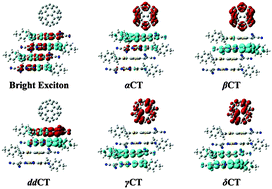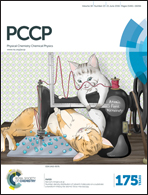The nature of excited states in dipolar donor/fullerene complexes for organic solar cells: evolution with the donor stack size†
Abstract
Electronic delocalization at donor/acceptor (D/A) interfaces can play an important role in photocurrent generation for organic solar cells. Here, we have investigated the nature of local excited and interfacial charge transfer (CT) states in model complexes including one to four anti-parallel stacking dipolar donor (DTDCTB) molecules and one fullerene (C60) molecule by means of density functional theory (DFT) and time-dependent DFT (TDDFT). For all the donor-to-acceptor CT states, despite the number of DTDCTB molecules in the complexes, the hole is mainly localized on a single DTDCTB, and moves farther away from C60 for the energy higher level. However, the highest occupied molecular orbitals (HOMOs) and the excitonic states (EX) including the bright and dark EX are delocalized over the whole donor stacks in the complexes. This implies that the formation of ordered DTDCTB arrangements can substantially shorten the exciton diffusion process and facilitate ultrafast charge generation. Interestingly, owing to strong intermolecular Coulomb attraction, the donor-to-donor CT states are situated below the local excited states, but can approach the donor-to-acceptor CT states, indicating a weak role as charge traps. Our work would be helpful for understanding the electronic delocalization effects in organic solar cells.


 Please wait while we load your content...
Please wait while we load your content...